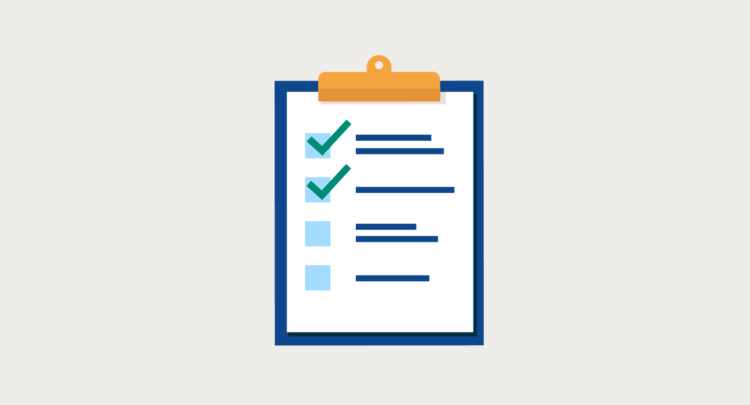At any time, personal injury paralegals might be juggling upwards of 100 personal injury files—all at different stages of the legal process. Because of this, it’s critical to ensure that your cases are organized. A good way to do so is by creating your own personal injury paralegal checklist, which can be an indispensable tool that significantly improves efficiency.
If you’d like a roadmap that guides you systematically through the intricate processes involved in handling personal injury cases, keep reading to learn more about what to include in a personal injury case checklist, how to start creating one for your practice, and tips on how to use such a checklist.
Why use a personal injury paralegal checklist?

Every personal injury case has its own nuances and complexities, and it’s easy to overlook details, especially when your firm is busy. Using a personal injury paralegal checklist helps you proactively make sure that no steps are missed during the different stages of a case.
Here are a few compelling benefits of incorporating a checklist into your workflow:
It clarifies all your tasks
A checklist streamlines your workflow by breaking down complex processes into smaller, more manageable tasks. This helps you stay on top of deadlines and assignments, and reduces the risk of overlooking critical details.
It standardizes your processes
Standardization is key in law. A checklist ensures that every case is handled consistently, minimizing the chances of human error and discrepancies. This consistency is particularly crucial in personal injury cases where precision is paramount.
It helps with time management
Personal injury cases often involve strict timelines for filing documents, responding to motions, and meeting court deadlines. A checklist helps paralegals and attorneys manage time more effectively, preventing last-minute rushes and reducing the stress associated with tight schedules.
It improves communication
A well-structured checklist improves a team’s communication, ensuring that everyone is on the same page, understands their roles and responsibilities, and ultimately contributes to the success of the case.
The key elements of a personal injury paralegal checklist

Every firm’s checklist will look a little different depending on how the practice runs, but as a general rule of thumb, consider including the following components:
Case intake and assessment
◻ Collect client information (via intake form, if you have one)
◻ Sign contingency fee agreement
◻ Sign HIPAA authorization
◻ Conduct initial interviews
◻ Assess case viability
◻ Determine potential conflicts of interest
Tip: In most cases, clients tend to ask similar questions over and over, so you may want to create a questionnaire or spreadsheet of your most common questions and answers to save time during the intake process.
Calendaring
Add key dates and tasks, such as the following, to your calendar:
◻ The statute of limitations, with multiple reminders
◻ Reminders to book depositions
◻ Other critical deadlines
◻ Medical status updates
◻ Reminders to reach out to experts or witnesses
Tip: Use Clio’s legal calendaring software to create events automatically based on rules and deadlines from hundreds of U.S. courts.
Investigation and evidence gathering
◻ Collect accident reports
◻ Interview witnesses and collect their information
◻ Obtain medical records, accident records, and wage loss records, as you’ll need these for your demand letter. This step tends to take quite a bit of time—start this process well in advance if you can.
◻ Obtain copies of insurance cards such as Medicare and or Medicaid, for later reference. If adjusters or insurance companies push back on bills or coverage, these records will be essential.
◻ Collect and document any other physical evidence such as photographs, videos and damage estimates. Has your client completed treatment? Have they achieved maximum medical improvement? On what date was this documented?
Legal research and analysis
◻ Research relevant laws and precedents
◻ Analyze liability and damages
◻ Prepare your medical narrative
Drafting legal documents
◻ Prepare demand letters
◻ Send the third-party insurer and/or your client’s insurer a letter of representation with a signed authorization.
◻ Draft complaints and responses
◻ Create discovery requests and responses
Court filings and deadlines
◻ File court documents in a timely manner
◻ Calendar court appearances and deadlines
◻ Monitor and respond to motions
Negotiation and settlement
◻ Communicate with opposing counsel
◻ Evaluate settlement offers
◻ Draft settlement agreements
Trial preparation
◻ Prepare trial notebooks
◻ Coordinate witness schedules
◻ Develop a trial strategy
Post-trial procedures
◻ Handle appeals, if necessary
◻ Execute settlement agreements
◻ Close out the case file
You may like these posts
Step-by-step guide to creating a personal injury paralegal checklist

Now that we know which key elements to include in a personal injury paralegal checklist, let’s explore how to create one, step by step:
1. Identify case-specific requirements
Tailor the checklist to the specific needs of each personal injury case. Consider the nature of the accident, type of injuries, and any unique circumstances that may affect the legal strategy.
2. Collaborate with your team
Work closely with attorneys and other members of your team to ensure that everyone’s input is considered. This collaboration ensures that the checklist aligns with the overall case strategy.
3. Implement a case management system to streamline the process and reduce human error
Leverage legal case management software and task management tools to create and execute your digital checklist.
For example, Clio Manage’s HIPAA-compliant personal injury law software can automate reminders, streamline intake, manage medical records, calculate settlements, track deadlines, and more.
It lets you make it easy for prospective clients to get in touch with your firm by creating online appointment booking and intake forms. Once clients are in your system, you can also use Clio Manage to:
- Schedule automated (but still personalized) messages and communications for clients.
- Track key case details (like your time, expenses, and case-specific information like insurance claim numbers, opposing parties, and incident dates).
- Pull information from custom fields into templates to automatically create personal injury case documents like complaints, discovery requests, and requests for medical records.
4. Establish a timeline and deadlines
Create a timeline for each stage of the case, including key milestones and deadlines. This timeline serves as a visual guide that helps you prioritize tasks and manage your workload effectively.
If you’re using a solution like Clio Manage, it will help you create this timeline of tasks automatically.
5. Review and update your checklist regularly
Personal injury cases are dynamic, and as your practice evolves, things will change. Regularly review and update the checklist to reflect any new developments, court rulings, or changes in case strategy—you could do this once a quarter or once a year, depending on how frequently you want to update the checklist.
Tips for effective utilization of a personal injury paralegal checklist
While having a checklist is beneficial, you must use it effectively to get the most out of it. Here are some tips for getting the most out of your personal injury paralegal checklist:
- Put a copy of the checklist at the front of each client’s file: This way, you can systematically check off requirements and tasks as you complete them and quickly assess what still needs to be done without having to read through every single file each time.
- Use the checklist to prioritize tasks: The nice thing about a checklist is you can customize it to make it easier to scan tasks based on urgency and importance. For example, you could order things chronologically by deadline or highlight urgent items.
- Delegate responsibilities: Clearly define roles and responsibilities within your team.
- Use technology and automation to streamline the process: If you’re not already, consider using a practice management solution that supports many of the items recommended for a personal injury paralegal checklist to help with automation.
- Stay flexible: While a checklist provides structure, it’s good to remain flexible because, ultimately, every case is unique. Legal proceedings can be unpredictable, and the ability to adapt the checklist to changing circumstances is crucial.
Ready to create your personal injury paralegal checklist?
A well-organized checklist that is diligently followed can make a significant difference in your firm’s efficiency and effectiveness.
While it’s possible to create a personal injury case checklist manually, there are many tools today that can make this process go much faster while minimizing chances for human error. Solutions like Clio Manage can simplify client communications, record management, and process management while helping you stay HIPAA-compliant. See how it works with a demo!
We published this blog post in March 2024. Last updated: .
Posted in: Business, Technology
See how Clio can help your law firm processes
Learn how firms level up their business with Clio.
See Clio in Action







